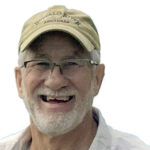Bob Mitchell: Early development of Table Rock Lake area
Before Table Rock Dam was completed in 1958, the area in and around the reservoir got an early look at what water would look like when an impoundment was in place. There are a number of recollections about this happening, none more memorable than a couple of Violaarea men who stepped up to an important job at the time and probably never got adequate recognition for their efforts, which is often the case in civilization.
These two, Earl Curry and Jake Turner, understood the importance of children from the Viola community getting to school in Shell Knob, but that was impossible. The Shell Knob-Viola Bridge was under water with only the upper girders visible. Curry lived on the road to Viola Boat Dock and Turner owned land that is now Green Shores subdivision.

Realizing the problem, they acquired a small boat and outboard motor and ran a ferry across the area on the Viola side of the early backwater, across to the other side. They were met twice a day by transportation on the Shell Knob shoreline and the youngsters never missed a day of school. Their project was compounded by safety. Life jackets were provided for each child, and on occasion, another craft would accompany them across the early floodwaters.
Their later lives
In later years, Curry was content to raise cattle on his land. His brother was a captain in the U.S. Coast Guard, and was once an unsuccessful candidate for commandant of the Hooligan Navy.
Turner sold his land, known as the Jim Couch place, to the Bernie Hougans who developed the property. He purchased land down Flat Creek from Cassville where he later milked cows.
Others in those years
It has been interesting to have lived in the early development years and knowing some of those who were instrumental in developing what has been one of Barry County’s fastest growing townships.
Storekeepers of the early era could have been what held the Shell Knob community together. Paramount among these were: Isaac Epperly, Frank Reeser, Millard Whisman and the Epperly operation.
Lots of landowners in the region were significant in the progress of the area. Many were displaced by Table Rock’s waters and forced to make purchases in other areas. Included in these were the Swafford and Loftin families, the first going to Mt. Grove and later moving to Cassville. Loftin later became presiding judge of the county court. Loftin’s story was
Loftin’s story was interesting as he was accused of wearing out two automobiles on trips to Washington, D. C., in opposition to the lake. He was also chided for making the effort, which considerably enhanced the sale of his Owen’s Bend property on James River to the government.
Early resort owners
Functioning to build the tourism industry of the lake region, early resort builders certainly had to play a big part in what exists in the Knob these days.
One of the first and most industrious toward the lake community was Cecil Davis, who with his wife Julia, built and operated Rod ‘n’ Reel Resort. Cecil was a Kansas City area building contractor, whose resort was in operation before roads were finished on the south shore of the old bridge as a result of early waters. He was also instrumental in formation and operation of Central Crossing Association and the first sports show appearance from this area for the Shell Knob-Roaring River Playgrounds Association.
Others included Gene Cooper at Hillcrest; Bert Cook at Bass Haven, Charles Myers and Stu Stewart at Hardman Hollow.
Many others followed, especially in the vicinity of Campbell Point Boat Dock after it was completed by Glen Hall.
Another of those leaders in the early development of the Knob was Howard McIlrath. His Hidden Cove Resort was at the downstream side of the Central Crossing Bridge. He was later involved in formation of a bank in the community and founded an insurance company.
McIlrath had the foresight to imagine Shell Knob’s formation as a village, capable of developing under some regulations. To put it as kindly as possible, he relied on some bad legal advice, and the effort was shot out of the saddle as being too involved and crossing county lines.
A favorite of ours
Coming out of South America where he had worked for an oil company, Alan Coogan, builder of the “brahouse” on Green Shores, wanted to keep his journalistic juices running and convinced Turkey Mountain, Inc., to publish a monthly newspaper. Thus the Knob Rock Rattler was born.
Coogan was one of those determined folks, insisting Air Force Academy grads here for our son’s wedding, use his home. I refused, but Sue accepted, and that was that. We discovered on early inspection, he had placed novels out of his extensive library around the home for the young men to read.
Our post inspection got the word from a housekeeper, the home was never in better condition, to the credit of the AF grads.
Bob Mitchell is the former editor and publisher of the Cassville Democrat. He is a 2017 inductee to both the Missouri Press Association Hall of Fame and Missouri Southern State University’s Regional Media Hall of Fame.
“Storekeepers of the early era could have been what held the Shell Knob community together. Paramount among these were: Isaac Epperly, Frank Reeser, Millard Whisman and the Epperly operation.”






